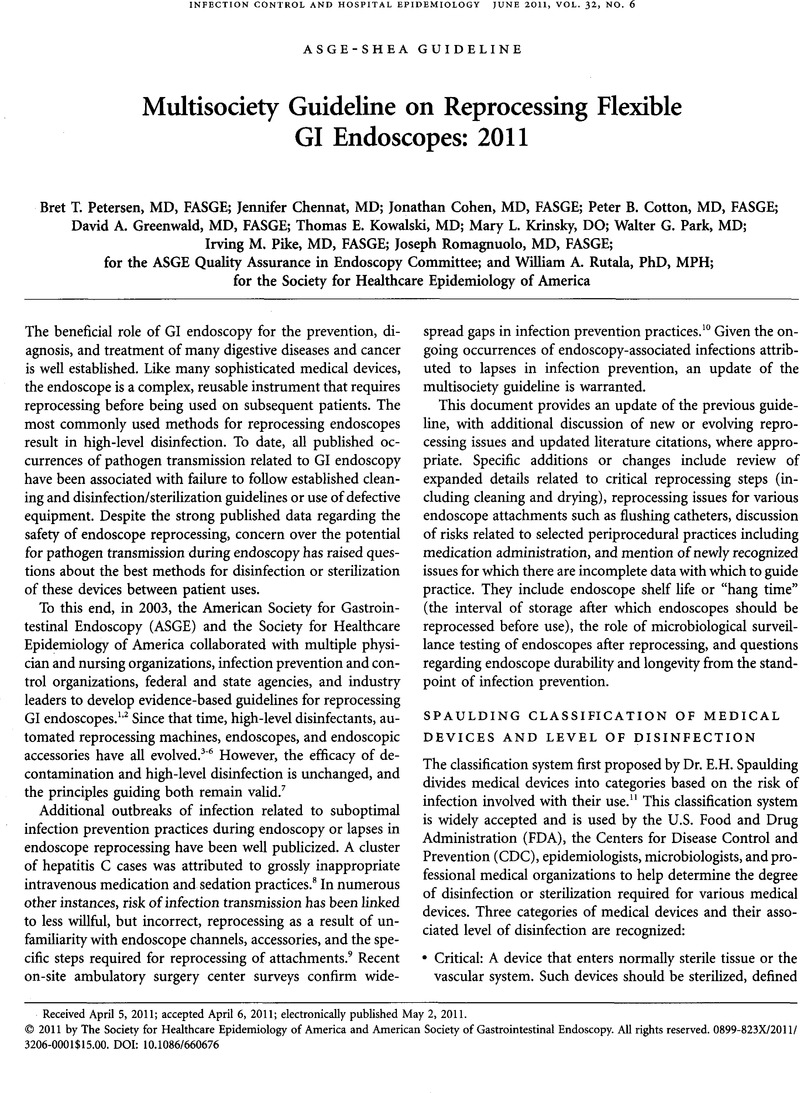Crossref Citations
This article has been cited by the following publications. This list is generated based on data provided by Crossref.
Costa, Cristina
Pina, Elaine
Ferreira, Etelvina
Ramos, Susana
Cremers, Marie Isabelle
Figueiredo, Pedro
Andrade, Joaquim
Monteiro, Elsa
Lemos Cunha Matos, Leopoldo Maria
and
Cotter, José
2012.
Reprocessamento em endoscopia digestiva.
GE Jornal Português de Gastrenterologia,
Vol. 19,
Issue. 5,
p.
241.
Siegel, Jane D.
2012.
Principles and Practice of Pediatric Infectious Diseases.
p.
9.
Weber, David J.
2012.
Managing and Preventing Exposure Events from Inappropriately Reprocessed Endoscopes.
Infection Control & Hospital Epidemiology,
Vol. 33,
Issue. 7,
p.
657.
Brooke, Joanna S.
2012.
Stenotrophomonas maltophilia: an Emerging Global Opportunistic Pathogen.
Clinical Microbiology Reviews,
Vol. 25,
Issue. 1,
p.
2.
Gray, R.A.
Williams, P.L.
Dubbins, P.A.
and
Jenks, P.J.
2012.
Decontamination of transvaginal ultrasound probes: Review of national practice and need for national guidelines.
Clinical Radiology,
Vol. 67,
Issue. 11,
p.
1069.
Bajolet, O.
Ciocan, D.
Vallet, C.
de Champs, C.
Vernet-Garnier, V.
Guillard, T.
Brasme, L.
Thiefin, G.
Cadiot, G.
and
Bureau-Chalot, F.
2013.
Gastroscopy-associated transmission of extended-spectrum beta-lactamase-producing Pseudomonas aeruginosa.
Journal of Hospital Infection,
Vol. 83,
Issue. 4,
p.
341.
Curran, Evonne T
2013.
Outbreak Column 9: Endoscopy-related outbreaks.
Journal of Infection Prevention,
Vol. 14,
Issue. 4,
p.
139.
Rutala, William A.
and
Weber, David J.
2013.
New developments in reprocessing semicritical items.
American Journal of Infection Control,
Vol. 41,
Issue. 5,
p.
S60.
Kovaleva, Julia
Peters, Frans T. M.
van der Mei, Henny C.
and
Degener, John E.
2013.
Transmission of Infection by Flexible Gastrointestinal Endoscopy and Bronchoscopy.
Clinical Microbiology Reviews,
Vol. 26,
Issue. 2,
p.
231.
Weber, David J.
and
Rutala, William A.
2013.
Assessing the risk of disease transmission to patients when there is a failure to follow recommended disinfection and sterilization guidelines.
American Journal of Infection Control,
Vol. 41,
Issue. 5,
p.
S67.
Dirlam Langlay, Alexandra M.
Ofstead, Cori L.
Mueller, Natalie J.
Tosh, Pritish K.
Baron, Todd H.
and
Wetzler, Harry P.
2013.
Reported gastrointestinal endoscope reprocessing lapses: The tip of the iceberg.
American Journal of Infection Control,
Vol. 41,
Issue. 12,
p.
1188.
Ofstead, Cori L.
Dirlam Langlay, Alexandra M.
Mueller, Natalie J.
Tosh, Pritish K.
and
Wetzler, Harry P.
2013.
Re-evaluating endoscopy-associated infection risk estimates and their implications.
American Journal of Infection Control,
Vol. 41,
Issue. 8,
p.
734.
Visrodia, Kavel H.
Ofstead, Cori L.
Yellin, Hannah L.
Wetzler, Harry P.
Tosh, Pritish K.
and
Baron, Todd H.
2014.
The Use of Rapid Indicators for the Detection of Organic Residues on Clinically Used Gastrointestinal Endoscopes with and without Visually Apparent Debris.
Infection Control & Hospital Epidemiology,
Vol. 35,
Issue. 8,
p.
987.
Akyüz, N.
Keskin, M.
Akyolcu, N.
Çavdar, İ.
Özbaş, A.
Ayoğlu, T.
Balık, E.
and
Bulut, T.
2014.
How and how much do endoscopy professionals protect themselves against infection?.
International Journal of Surgery,
Vol. 12,
Issue. 7,
p.
720.
2014.
Cotton and Williams' Practical Gastrointestinal Endoscopy.
p.
6.
Kampf, Günter
2014.
Is peracetic acid suitable for the cleaning step of reprocessing flexible endoscopes?.
World Journal of Gastrointestinal Endoscopy,
Vol. 6,
Issue. 9,
p.
390.
Faro, Albert
Wood, Robert E.
Schechter, Michael S.
Leong, Albin B.
Wittkugel, Eric
Abode, Kathy
Chmiel, James F.
Daines, Cori
Davis, Stephanie
Eber, Ernst
Huddleston, Charles
Kilbaugh, Todd
Kurland, Geoffrey
Midulla, Fabio
Molter, David
Montgomery, Gregory S.
Retsch-Bogart, George
Rutter, Michael J.
Visner, Gary
Walczak, Stephen A.
Ferkol, Thomas W.
and
Michelson, Peter H.
2015.
Official American Thoracic Society Technical Standards: Flexible Airway Endoscopy in Children.
American Journal of Respiratory and Critical Care Medicine,
Vol. 191,
Issue. 9,
p.
1066.
Rutala, William A.
and
Weber, David J.
2015.
Mandell, Douglas, and Bennett's Principles and Practice of Infectious Diseases.
p.
3294.
Saliou, Philippe
Cholet, Franck
Jézéquel, Julien
Robaszkiewicz, Michel
Le Bars, Hervé
and
Baron, Raoul
2015.
The Use of Channel-Purge Storage for Gastrointestinal Endoscopes Reduces Microbial Contamination.
Infection Control & Hospital Epidemiology,
Vol. 36,
Issue. 9,
p.
1100.
Ofstead, Cori L.
Wetzler, Harry P.
Doyle, Evan M.
Rocco, Catherine K.
Visrodia, Kavel H.
Baron, Todd H.
and
Tosh, Pritish K.
2015.
Persistent contamination on colonoscopes and gastroscopes detected by biologic cultures and rapid indicators despite reprocessing performed in accordance with guidelines.
American Journal of Infection Control,
Vol. 43,
Issue. 8,
p.
794.


